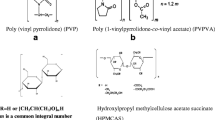Abstract
Purpose. The deformation behaviors of compressedfreeze-dried and spray-dried tolbutamide/hydroxypropyl-β-cyclodextrinmolecular dispersions were evaluated and compared with similarly preparedtolbutamides (TBM), hydroxypropyl-β-cyclodextrins (HP-β-CD) and astheir physical dispersions.
Methods. TBM, HP-β-CD, and their 1:1 moleculardispersions were prepared by freeze-drying and spray-drying, and physicaldispersions of TBM and HP-β-CD were blended. Deformation properties ofthe prepared materials were evaluated by using a compaction simulator andconstants derived from Heckel plots. Molecular dynamics (MD) simulationswere performed in order to gain a molecular-level view on the deformationbehavior of TBM-HP-β-CD inclusion complex.
Results. The freeze-dried TBM polymorphic form II was lessprone to overall particle deformation than the spray-dried stable form I.Formation of molecular dispersions decreased the plastic and elasticbehaviors of these materials. Also, the MD simulations showed a reducedmolecular flexibility of the TBM-HP-β-CD inclusion complex, as comparedto HP-β-CD.
Conclusions. The formation of TBM and HP-β-CDmolecular dispersion resulted in more rigid molecular arrangements, whichwere less prone to deformation than either HP-β-CDs or physicaldispersions. The results showed how differing molecular, solid, particle,and powder state properties affect the deformation properties of thematerials studied.
Similar content being viewed by others
REFERENCES
A. Muñ oz-Ruiz and P. Paronen. Time-dependent densification behavior of cyclodextrins. J. Pharm. Pharmacol. 48:790–797 (1996).
G. S. Pande and R. F. Shangraw. Characterization of β-cyclodextrin for direct compression tableting. Int. J. Pharm. 101:71–80 (1994).
G. S. Pande and R. F. Shangraw. Characterization of β-cyclodextrin for direct compression tableting: II. The role of moisture in the compactibility of β-cyclodextrin. Int. J. Pharm. 124:23–239 (1995).
T. Tsai, J.-S. Wu, H.-O. Ho, and M. T. Sheu. Modification of physical characteristics of microcrystalline cellulose by codrying with β-cyclodextrin. J. Pharm. Sci. 87:117–122 (1998).
Lj. Tasic, K. Pintye-Hó di, and P. Sabo-Revesz. Evaluation of compression behavior of paracetamol tablets produced with β-cyclodextrin dispersions. Part II. Energy distribution study of tablets. Drug Dev. Ind. Pharm. 23:1153–1158 (1997).
K. B. Lipkowitz. Applications of computational chemistry to the study of cyclodextrins. Chem. Rev. 98:1829–1873 (1998).
J. E. H. Koehler, W. Saenger, and W. F. van Gunsteren. Conformational differences between β-cyclodextrin in aqueous solution and in crystalline form. A molecular dynamics study. J. Mol. Biol. 203:241–250 (1988).
E. Suihko, O. Korhonen, T. Järvinen, A. Poso, J. Ketolainen, E. Laine, and P. Paronen. Preparation and characterization of a solid tolbutamide: Hydroxypropyl-β-cyclodextrin inclusion complex. AAPS Pharm. Sci. 1(Suppl):3731 (1999).
E. Suihko, O. Korhonen, T. Järvinen, J. Ketolainen, E. Laine, and P. Paronen. Evaluation of the physical properties of a tolbutamide/hydroxypropyl-β-cyclodextrin inclusion complex. In M. H. Rubinstein (ed.), Proceedings in the 16th Pharmaceutical Technology Conference, Athens, Greece, 1997, vol. 2, pp. 286–294.
K. Kimura, F. Hirayama, H. Arima, and K. Uekama. Solid-state 13C nuclear magnetic resonance spectroscopic study on amorphous solid complexes of tolbutamide with 2-hydroxypropyl-α-and-β-cyclodextrins. Pharm. Res. 16:1729–1734 (1999).
K. Kimura, F. Hirayama, and K. Uekama. Characterization of tolbutamide polymorphs (Burger's forms II and IV) and polymorphic transition behavior. J. Pharm. Sci. 88:385–391 (1999).
H. Rumpf. The characteristics of system and their changes of state. In B. Scarlett (ed.), Particle Technology, Chapman and Hall, London, UK, 1990, pp. 14–15.
R. W. Heckel. Density pressure relationship in powder compaction. Trans. Metall. Soc. AIME. 221:671–675 (1961a).
R. W. Heckel. An analysis of powder compaction phenomena. Trans. Metall. Soc. AIME. 221:1001–1008 (1961b).
P. Paronen and M. J. Juslin. Compressional characteristics of four starches. J. Pharm. Pharmacol. 35:627–635 (1983).
R. J. Roberts and R. C. Rowe. The effect of punch velocity on the compaction of a variety of materials. J. Pharm. Pharmacol. 37:377–384 (1985).
K. A. Nirmala and D. S. Sake Gowda. Structure determination of tolbutamide. Acta Crystallogr., Sect. B 37:1597–1599 (1981).
P. Charpin, I. Nicolis, F. Villain, C. de Rango, and A. W. Coleman. β-Cyclodextrin-potassium hydroxide-water (1/1/8). Acta Crystallogr., Sect. C (Cr. Str. Comm.) 47:1829–1832 (1991).
E. Doelker. Recent advances in tableting science. Boll. Chim. Pharm. 127:37–49 (1988).
P. Paronen. Heckel plots as indicators of elastic properties. In M. Rubinstein (ed.), Tablet technology, vol. 1. Ellis Horwood, England, 1987, pp. 139–144.
L. W. Wong and N. Pilpel. The effect of particle shape on the mechanical properties of powders. Int. J. Pharm. 59:145–154 (1990).
H. Vromans, G. K. Bolhuis, C. F. Lerk, K. D. Kussendrager, and H. Bosch. Studies on tableting properties of lactose. VI. Consolidation and compaction of spray dried amorphous lactose. Acta Pharm. Suec. 23:231–240 (1986).
S. P. Duddu and K. Weller. Importance of glass transition temperature in accelerated stability testing of amorphous solids: Case study using a lyophilized aspirin formulation. J. Pharm. Sci. 85:345–347 (1996).
A. Nokhodchi, J. L. Ford, P. H. Rowe, and M. H. Rubinstein. The effect of moisture on the Heckel and energy analysis of hydroxypropylmethylcellulose 2208 (HPMC K4M). J. Pharm. Pharmacol. 48:1122–1127 (1996).
Humbert-Droz, R. Gurny, D. Mordier, and E. Doelker. Densification behaviour of drugs presenting availability problems. Int. J Pharm. Technol. Prod. Manuf. 4:29–35 (1983).
R. J. Roberts and R. C. Rowe. Mechanical properties. In G. Alderborn and C. Nyströ (eds.), Pharmaceutical powder compaction technology, Marcel Dekker Inc., New York, NY, 1996, pp. 283–322.
Ragnarsson and J. Sjögren. Compressibility and tablet properties of two polymorphs of metoprolol tartrate. Acta Pharm. Suec. 21:321–329 (1984).
Kopp-Kubel, C. Beyer, E. Graf, F. Kubel, and E. Doelker. Einfluss der Polymorphie von Phenobarbital auf Tabletteneigenschaffen. Eur. J. Pharm. Biopharm. 38:17–25 (1992).
P. Berthault, D. Dushesne, H. Desvaux, and B. Gilquin. A self-included cyclomaltoheptaose derivative studied by NMR spectroscopy and molecular modelling. Carbohydr. Res. 278:267–287 (1995).
Muñoz-Botella, M. A. Martin, B. del Castillo, and L. Vásquez. Differentiating inclusion complexes from host molecules by tapping-mode atomic force microscopy. Biophys. J. 71:86–90 (1996).
Author information
Authors and Affiliations
Rights and permissions
About this article
Cite this article
Suihko, E., Poso, A., Korhonen, O. et al. Deformation Behaviors of Tolbutamide, Hydroxypropyl-β-Cyclodextrin, and Their Dispersions. Pharm Res 17, 942–948 (2000). https://doi.org/10.1023/A:1007523103979
Issue Date:
DOI: https://doi.org/10.1023/A:1007523103979




